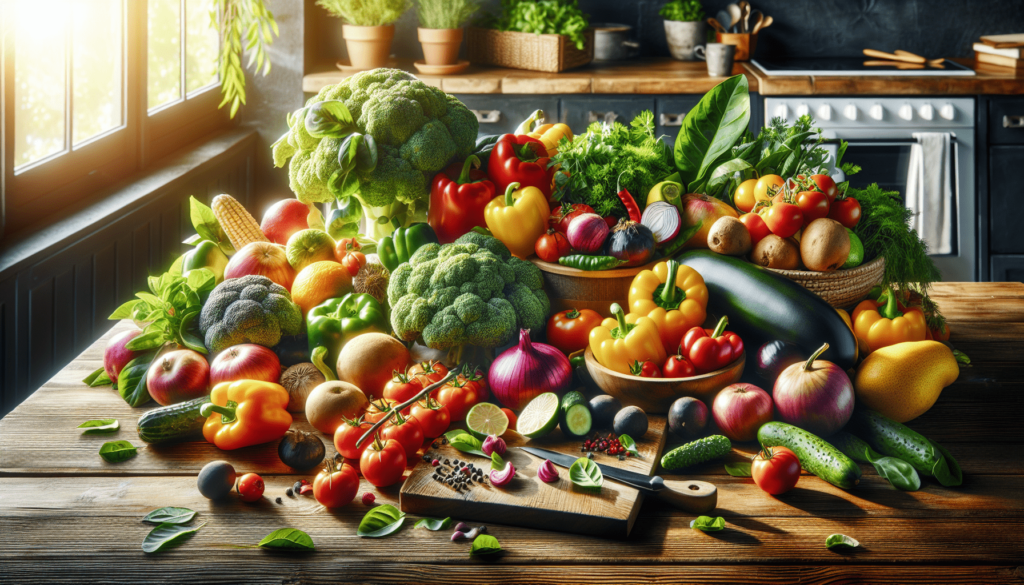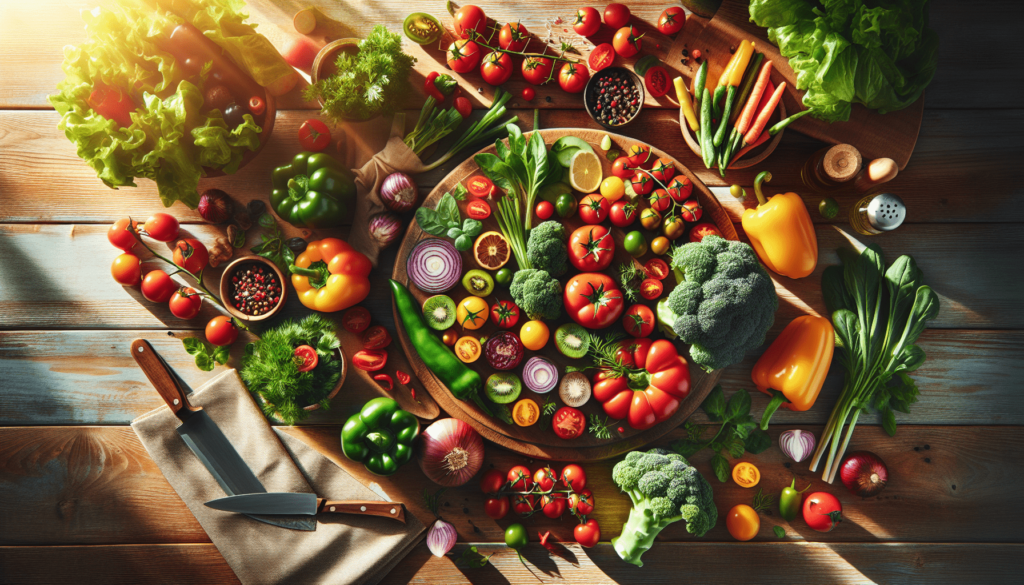Have you ever wondered how to bring a vibrant touch to your culinary creations without sacrificing your commitment to health? Cooking is not just about taste; it’s also about nourishing your body and soul. When you’re a cooking enthusiast, there’s a unique pleasure in crafting dishes that are both delectable and beneficial for your well-being. This piece will guide you through a collection of healthy recipes that promise to tantalize your taste buds without compromising on nutrition.

The Importance of Healthy Cooking
Cooking your own meals can provide a deep sense of satisfaction, not to mention numerous health benefits. When you focus on healthy recipes, you open doors to a lifestyle that supports your physical and mental well-being. By preparing your own meals, you control the ingredients, reduce additives, and harness the benefits of whole foods that are packed with nutrients.
Ingredients: Choose Wisely
The cornerstone of any healthy recipe is its choice of ingredients. Organic fruits and vegetables, whole grains, lean proteins, and healthy fats enrich your body with essential nutrients. Opting for these ingredients can greatly influence the nutritional density of your meals.
Fruits and Vegetables
These are the powerhouse of nutrients, providing vitamins, minerals, fiber, and antioxidants. Incorporating a variety of colors ensures a wide range of nutrients.
Whole Grains
Whole grains like quinoa, brown rice, and oats are excellent sources of energy. They are rich in fiber, which aids digestion and helps you feel fuller for longer.
Lean Proteins
Lean meats, fish, legumes, and tofu are packed with proteins that are essential for muscle repair and growth. They are typically low in unhealthy fats, making them a better choice for heart health.
Healthy Fats
Incorporate fats like avocados, nuts, seeds, and olive oil. They are rich in omega-3 and omega-6 fatty acids, essential for brain health and inflammation reduction.
Recipe 1: Quinoa and Black Bean Salad
This vibrant dish brings together a punch of flavors and nutrients. It’s hearty enough to stand alone as a main dish or serve as a side.
Ingredients
- 1 cup quinoa
- 2 cups water
- 1 can black beans, drained and rinsed
- 1 cup cherry tomatoes, halved
- 1 bell pepper, diced
- 1 avocado, diced
- Juice of 1 lime
- 2 tablespoons olive oil
- Salt and pepper to taste
- Fresh cilantro for garnish
Instructions
- Rinse the quinoa under cold water. In a saucepan, combine quinoa and water. Bring to a boil, then cover and reduce to a simmer for about 15 minutes or until the water is absorbed.
- In a large bowl, combine the cooked quinoa, black beans, cherry tomatoes, bell pepper, and avocado.
- In a small jar, mix lime juice, olive oil, salt, and pepper. Shake well and pour over the salad.
- Toss everything together and garnish with fresh cilantro before serving.
Nutritional Benefits
This salad is a powerhouse of plant-based protein, healthy fats, and vitamins. Quinoa is a complete protein, while black beans add fiber and antioxidants. Avocado provides creamy texture along with heart-healthy fats.
Recipe 2: Baked Salmon with Herbs and Asparagus
Fish like salmon is rich in omega-3 fatty acids, beneficial for heart health. Baking retains most nutrients and is a healthier cooking method compared to frying.
Ingredients
- 4 salmon fillets
- 1 bunch asparagus, trimmed
- 2 tablespoons olive oil
- 2 tablespoons lemon juice
- Salt and pepper to taste
- Fresh dill and parsley for garnish
Instructions
- Preheat your oven to 375°F (190°C).
- Arrange salmon fillets and asparagus on a baking sheet lined with parchment paper.
- Drizzle olive oil and lemon juice over salmon and asparagus. Sprinkle with salt, pepper, dill, and parsley.
- Bake for 15-20 minutes or until salmon flakes easily with a fork.
- Serve hot with an additional sprinkle of fresh herbs.
Nutritional Benefits
Salmon is not only delicious but it’s also a good source of omega-3 fatty acids. Asparagus is low in calories and high in vitamins K, A, and E. This dish strikes a perfect balance between delectable taste and nutritional density.
Recipe 3: Lentil Soup with Spinach
A warm bowl of lentil soup is perfect for any day. Lentils are a fantastic source of plant protein, making this soup both filling and nutritious.
Ingredients
- 1 cup lentils
- 6 cups vegetable broth
- 1 onion, chopped
- 3 cloves garlic, minced
- 2 carrots, diced
- 2 celery stalks, diced
- 2 cups fresh spinach
- 1 tablespoon olive oil
- 1 teaspoon thyme
- Salt and pepper to taste
- Grated parmesan cheese for garnish (optional)
Instructions
- Heat olive oil in a large pot over medium heat. Add onion, garlic, carrots, and celery. Sauté until vegetables are tender.
- Stir in the lentils and thyme, then add the vegetable broth. Bring to a boil, reduce heat, and simmer for 25-30 minutes until lentils are tender.
- Add spinach and cook for an additional 5 minutes until wilted. Season with salt and pepper.
- Serve hot with a sprinkle of parmesan cheese if desired.
Nutritional Benefits
Lentils are chock-full of protein, fiber, and iron, while spinach adds a boost of vitamins A and C. This soup not only strengthens your immune system but also supports digestion.

Recipe 4: Sweet Potato and Chickpea Curry
For those who love a bit of spice, this curry is a must-try. It’s rich, flavorful, and packed with nutrients.
Ingredients
- 2 medium sweet potatoes, cubed
- 1 can chickpeas, drained
- 1 onion, diced
- 3 cloves garlic, minced
- 2 tablespoons curry powder
- 1 can coconut milk
- 1 tablespoon olive oil
- 2 tomatoes, chopped
- Salt to taste
- Fresh coriander for garnish
Instructions
- Heat olive oil in a pot over medium heat. Add onion and garlic, sauté until translucent.
- Add curry powder and stir for 1 minute until fragrant.
- Pour in coconut milk and bring to a simmer. Add sweet potatoes and cook for about 10 minutes.
- Stir in chickpeas and tomatoes. Continue cooking until sweet potatoes are tender.
- Season with salt and garnish with fresh coriander before serving.
Nutritional Benefits
This curry brings together the earthy sweetness of potatoes with the richness of chickpeas, both excellent for fiber and protein. Coconut milk adds creaminess while providing healthy fats.
Recipe 5: Whole Wheat Pasta Primavera
This pasta dish is a celebration of seasonal vegetables. Using whole wheat pasta ensures you’re getting more fiber and nutrients.
Ingredients
- 8 oz whole wheat pasta
- 1 zucchini, sliced
- 1 cup cherry tomatoes, halved
- 1 bell pepper, sliced
- 1 carrot, julienned
- 2 cloves garlic, minced
- 2 tablespoons olive oil
- 1 teaspoon dried oregano
- Salt and pepper to taste
- Grated parmesan or nutritional yeast for garnish (optional)
Instructions
- Cook the pasta according to package instructions. Drain and set aside.
- In a large pan, heat olive oil. Add garlic and sauté for 1 minute.
- Add zucchini, cherry tomatoes, bell pepper, and carrot. Cook until vegetables are tender but still crisp.
- Stir in cooked pasta, oregano, salt, and pepper.
- Serve with a sprinkle of parmesan or nutritional yeast.
Nutritional Benefits
Whole wheat pasta is a great choice for increasing dietary fiber. The medley of vegetables adds vitamins, minerals, and antioxidants, making this dish nourishing and satisfying.
The Art of Balancing Flavors and Nutrition
Crafting healthy recipes is an art that involves balancing flavors without compromising nutritional integrity. You’re encouraged to experiment with spices, herbs, and natural sweeteners to elevate the taste. Emphasize fresh produce and lean, nutrient-rich ingredients to enhance health benefits.
Spices and Herbs
These can transform a dish without adding calories. For instance, turmeric has anti-inflammatory properties, while basil and coriander can aid digestion.
Natural Sweeteners
Instead of refined sugars, turn to honey, maple syrup, or stevia for sweetness. These options not only provide a similar taste but also add a hint of natural nutrients.
Mindful Portion Control
Healthy eating is not just about what you eat but also how much you eat. Mindful portion control helps in maintaining a balanced diet and prevents overeating.
Getting Creative with Presentations
A dish looks as good as it tastes, don’t you agree? A well-presented meal enhances the dining experience, making healthy eating more enjoyable. Try vibrant garnishes, colorful ingredients, and thoughtful plating to elevate the aesthetic of your meals.
Plating Tips
- Use a variety of textures and colors to make the dish look appealing.
- Consider the plate size, allowing enough space for your food to look neat yet bountiful.
- Add finishing touches like a sprinkle of herbs or a drizzle of sauce right before serving.
Conclusion: Your New Culinary Adventure
Engaging with healthy recipes is a rewarding journey for any cooking enthusiast. It pushes the boundaries of creativity while promoting well-being. Equipped with this collection of recipes and tips, you are ready to embark on a culinary adventure that delights and nourishes in equal measure. Enjoy experimenting with flavors, textures, and methods, and take pleasure in knowing that each dish you craft is a step towards a healthier, more vibrant lifestyle.
Some of the links on this site are affiliate links, which means I may earn a small commission if you click on them and make a purchase, at no additional cost to you. As an Amazon Associate, I earn from qualifying purchases.



